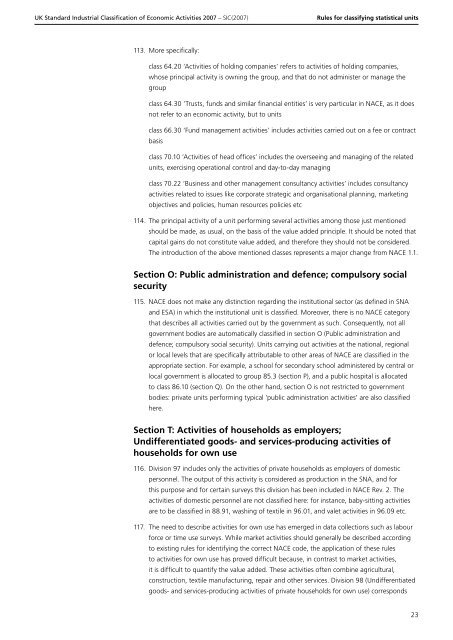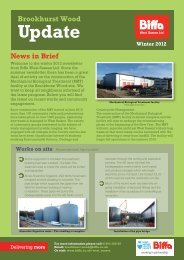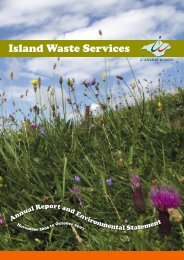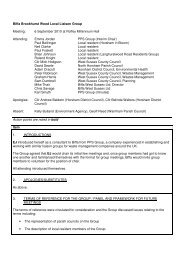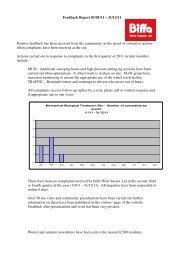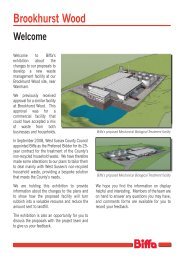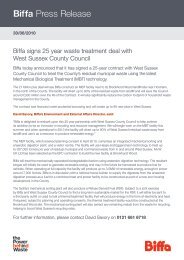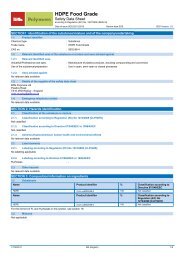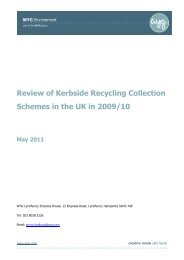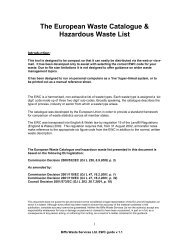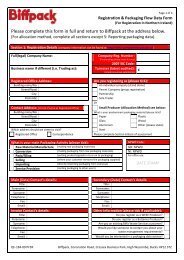detailed explanation for each SIC code - Biffa
detailed explanation for each SIC code - Biffa
detailed explanation for each SIC code - Biffa
You also want an ePaper? Increase the reach of your titles
YUMPU automatically turns print PDFs into web optimized ePapers that Google loves.
UK Standard Industrial Classification of Economic Activities 2007 – <strong>SIC</strong>(2007)<br />
Rules <strong>for</strong> classifying statistical units<br />
113. More specifically:<br />
class 64.20 ‘Activities of holding companies’ refers to activities of holding companies,<br />
whose principal activity is owning the group, and that do not administer or manage the<br />
group<br />
class 64.30 ‘Trusts, funds and similar financial entities’ is very particular in NACE, as it does<br />
not refer to an economic activity, but to units<br />
class 66.30 ‘Fund management activities’ includes activities carried out on a fee or contract<br />
basis<br />
class 70.10 ‘Activities of head offices’ includes the overseeing and managing of the related<br />
units, exercising operational control and day-to-day managing<br />
class 70.22 ‘Business and other management consultancy activities’ includes consultancy<br />
activities related to issues like corporate strategic and organisational planning, marketing<br />
objectives and policies, human resources policies etc<br />
114. The principal activity of a unit per<strong>for</strong>ming several activities among those just mentioned<br />
should be made, as usual, on the basis of the value added principle. It should be noted that<br />
capital gains do not constitute value added, and there<strong>for</strong>e they should not be considered.<br />
The introduction of the above mentioned classes represents a major change from NACE 1.1.<br />
Section O: Public administration and defence; compulsory social<br />
security<br />
115. NACE does not make any distinction regarding the institutional sector (as defined in SNA<br />
and ESA) in which the institutional unit is classified. Moreover, there is no NACE category<br />
that describes all activities carried out by the government as such. Consequently, not all<br />
government bodies are automatically classified in section O (Public administration and<br />
defence; compulsory social security). Units carrying out activities at the national, regional<br />
or local levels that are specifically attributable to other areas of NACE are classified in the<br />
appropriate section. For example, a school <strong>for</strong> secondary school administered by central or<br />
local government is allocated to group 85.3 (section P), and a public hospital is allocated<br />
to class 86.10 (section Q). On the other hand, section O is not restricted to government<br />
bodies: private units per<strong>for</strong>ming typical ‘public administration activities’ are also classified<br />
here.<br />
Section T: Activities of households as employers;<br />
Undifferentiated goods- and services-producing activities of<br />
households <strong>for</strong> own use<br />
116. Division 97 includes only the activities of private households as employers of domestic<br />
personnel. The output of this activity is considered as production in the SNA, and <strong>for</strong><br />
this purpose and <strong>for</strong> certain surveys this division has been included in NACE Rev. 2. The<br />
activities of domestic personnel are not classified here: <strong>for</strong> instance, baby-sitting activities<br />
are to be classified in 88.91, washing of textile in 96.01, and valet activities in 96.09 etc.<br />
117. The need to describe activities <strong>for</strong> own use has emerged in data collections such as labour<br />
<strong>for</strong>ce or time use surveys. While market activities should generally be described according<br />
to existing rules <strong>for</strong> identifying the correct NACE <strong>code</strong>, the application of these rules<br />
to activities <strong>for</strong> own use has proved difficult because, in contrast to market activities,<br />
it is difficult to quantify the value added. These activities often combine agricultural,<br />
construction, textile manufacturing, repair and other services. Division 98 (Undifferentiated<br />
goods- and services-producing activities of private households <strong>for</strong> own use) corresponds<br />
23


